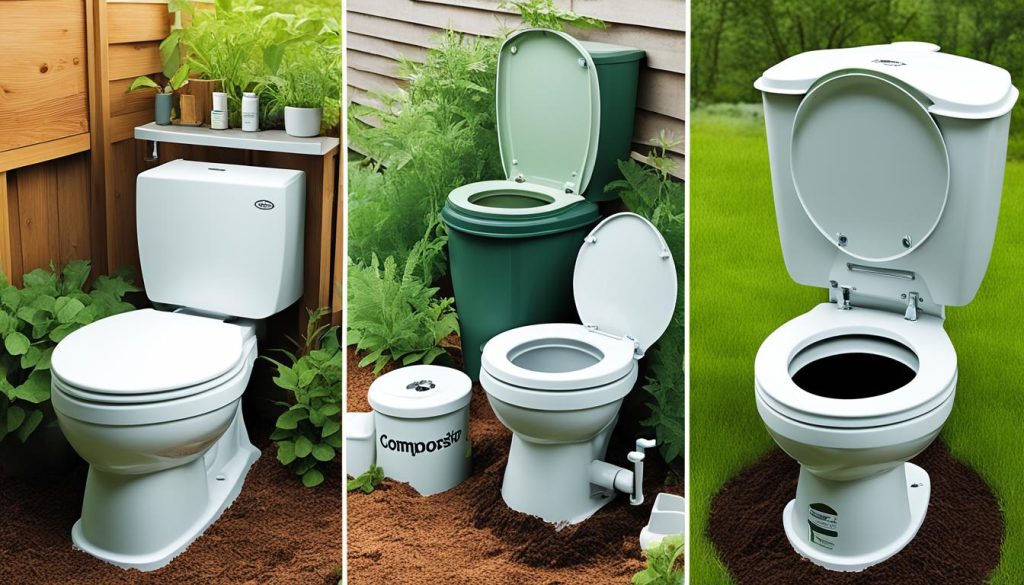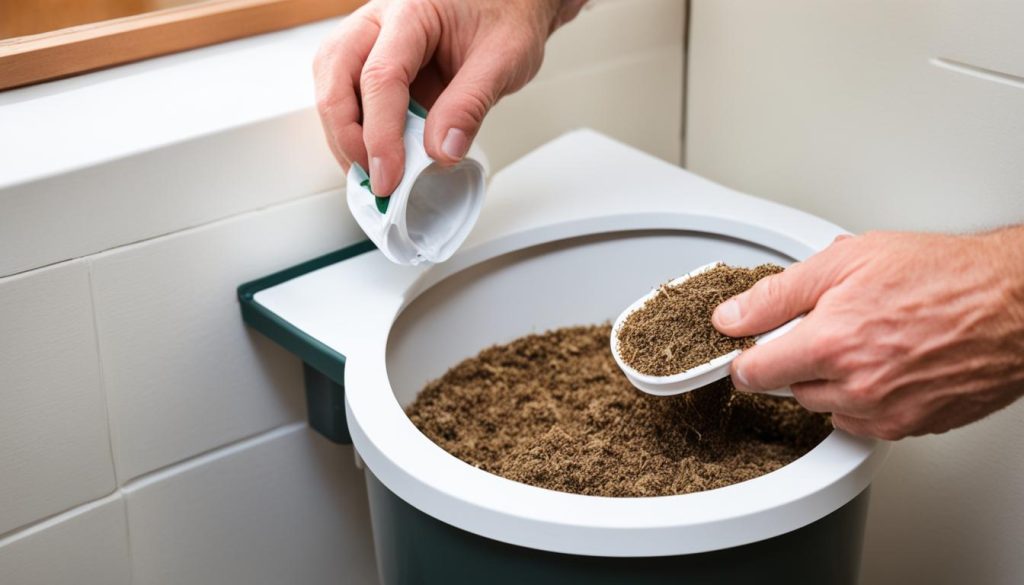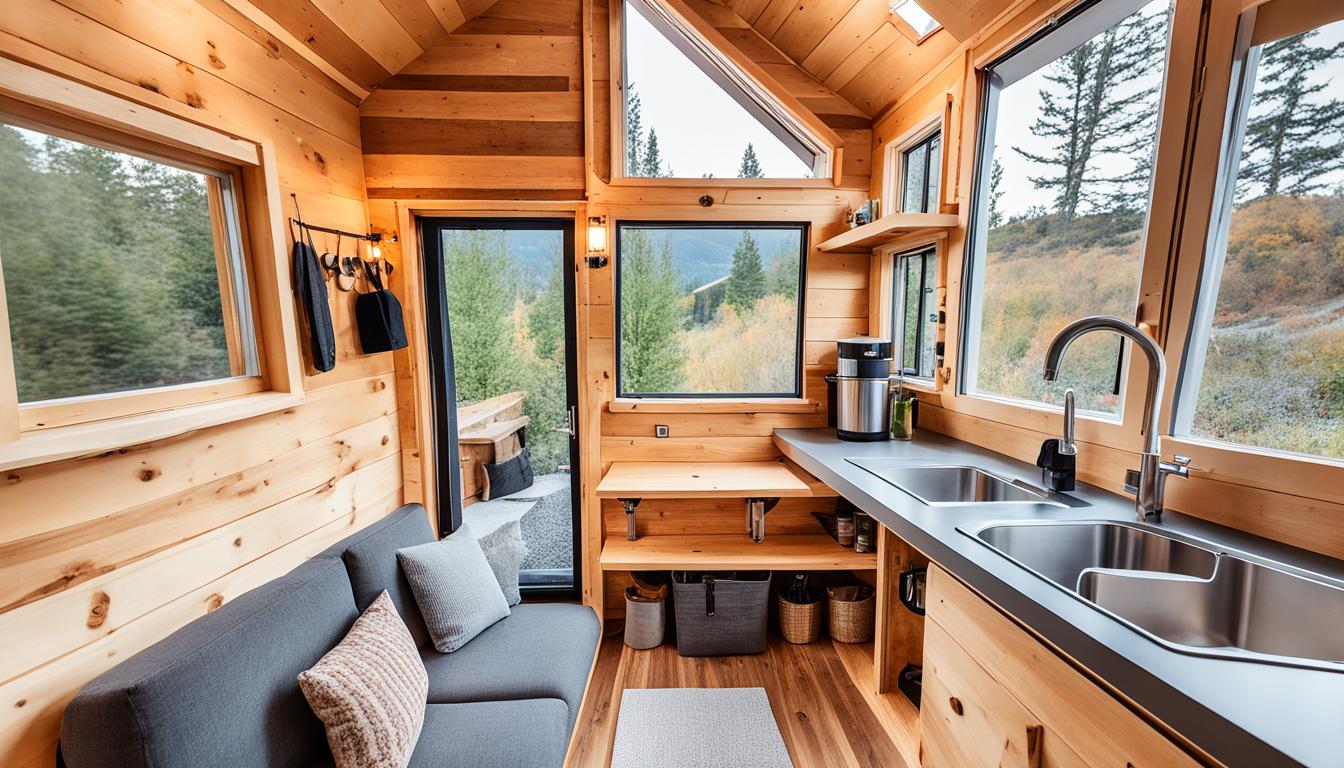Did you know that composting toilets are not only eco-friendly but also an ideal solution for tiny houses? With the growing popularity of small space living and the need for sustainable alternatives, composting toilets have become a go-to option for those seeking a compact and environmentally conscious toilet system.
When living in a tiny house, every square foot counts, and traditional toilets can take up valuable space. Additionally, connecting to a sewage or septic system may not always be feasible, especially for those living off-grid. This is where composting toilets shine, offering a practical and efficient way to manage waste in small spaces.
Key Takeaways:
- Composting toilets are an eco-friendly option for tiny houses.
- They provide a compact and space-saving solution for waste management.
- Composting toilets are ideal for off-grid living and don’t require a sewage or septic connection.
- Choosing the right composting toilet involves considering factors such as space-saving features, power source, and installation requirements.
- The HomeBiogas Bio-Toilet Kit offers an innovative and sustainable solution for composting toilets in tiny houses.
Benefits of Composting Toilets for Tiny Houses
Composting toilets offer several advantages for tiny house living. Firstly, they are ideal for off-grid living, as they do not require a sewage or septic connection. This makes them perfect for those looking to live sustainably and independently.
Composting toilets are also sustainable bathroom fixtures, as they utilize natural processes to break down human waste and transform it into nutrient-rich compost. This eco-friendly approach reduces water consumption and eliminates the need for traditional wastewater treatment systems. With composting toilets, you can actively contribute to environmental conservation and minimize your ecological footprint.
Furthermore, composting toilets are compact and space-saving. Their innovative design allows for efficient waste management without occupying excessive space in your tiny house bathroom. This is particularly important when every inch counts in small living spaces. By choosing a composting toilet, you can optimize the functionality of your bathroom while ensuring a comfortable and convenient sanitation solution.
Benefits Recap:
- Off-grid living without the need for sewage or septic connection
- Eco-friendly and sustainable bathroom fixture
- Reduces water consumption and environmental impact
- Compact and space-saving design for tiny houses
Top Composting Toilet Options for Tiny Houses
When it comes to composting toilets for tiny houses, two highly recommended options are the Separett Villa and Nature’s Head. Both of these composting toilet models have garnered positive reviews from tiny house owners due to their efficiency and eco-friendly features.
The Separett Villa, proudly made in Sweden, offers a unique design that separates urine from solid waste, resulting in a nearly odor-free process. This separation also allows for easy disposal of solid waste in a compost bin or garbage. The Separett Villa is a popular choice for those seeking a hassle-free composting toilet solution.
On the other hand, Nature’s Head composting toilet is renowned for its built-in urine diverter. This feature ensures the diversion of urine away from the solid waste, contributing to the composting process. Nature’s Head composting toilet also requires proper venting to the outdoors to maintain optimal performance.
For those looking for a simpler and cost-effective composting toilet system, a bucket system as described in the Humanure Handbook can be a viable option. This system utilizes a basic composting bucket setup, allowing for convenient waste management in a tiny house.
The table below summarizes the key features of these top composting toilet options:
| Composting Toilet | Key Features |
|---|---|
| Separett Villa | Separates urine from solid waste Nearly odor-free process Easy disposal of solid waste |
| Nature’s Head | Built-in urine diverter Requires venting to the outdoors |
| Bucket System | Cost-effective option Simple composting bucket setup |

When selecting a composting toilet for your tiny house, consider your specific needs and preferences. The Separett Villa and Nature’s Head offer advanced features for improved convenience and odor control. Alternatively, a bucket system provides an affordable and sustainable option for waste management. Choose the composting toilet that best suits your tiny house lifestyle and contributes to your eco-friendly goals.
Maintenance of Composting Toilets in Tiny Houses
Proper maintenance is crucial for ensuring the efficient and odor-free operation of a composting toilet in a tiny house. By regularly performing key tasks, you can keep your composting toilet in optimal condition. Here are the essential maintenance steps for your composting toilet:
- Emptying the urine diverter and solid waste compartment: Regularly emptying the urine diverter and solid waste compartment prevents excessive accumulation and minimizes odors. Dispose of the waste according to local regulations and guidelines.
- Cleaning the fan filters: The fan filters help remove odors and maintain proper ventilation in the toilet. Clean them regularly by gently brushing or vacuuming to ensure uninterrupted airflow.
- Sanitizing the toilet: To maintain hygiene, it’s important to sanitize the toilet regularly. Use environmentally friendly cleaning solutions, such as a mixture of bicarbonate of soda and vinegar, to clean the surfaces of the composting toilet.
- Wiping down the composting toilet: A weekly wipe-down of the composting toilet helps remove any residue and keeps it clean. Use a damp cloth or eco-friendly cleaning wipes to wipe all surfaces, including the seat and handles. Do not use harsh chemicals or abrasive cleaning materials.
- Inspecting the urine diverter: Regularly inspect the urine diverter for any damage or wear. Replace it if necessary to maintain proper separation of urine and solid waste.
- Emptying the composting chamber: The composting chamber should be emptied less frequently compared to the urine diverter and solid waste compartment. The frequency depends on the size of the chamber and the usage. When emptying the composting chamber, add composting agent to aid in the decomposition process.
By following these maintenance guidelines, you can ensure that your composting toilet functions effectively, remains odor-free, and contributes to a clean and sustainable environment in your tiny house.

| Maintenance Task | Frequency |
|---|---|
| Emptying the urine diverter and solid waste compartment | Regularly |
| Cleaning the fan filters | Regularly |
| Sanitizing the toilet | Regularly |
| Wiping down the composting toilet | Weekly |
| Inspecting the urine diverter | Regularly |
| Emptying the composting chamber | Less frequently |
Factors to Consider When Choosing a Composting Toilet for a Tiny House
When selecting a composting toilet for a tiny house, there are several important factors to take into consideration. The space-saving features, power source, and installation requirements of the toilet play a crucial role in finding the right fit for your small space. Let’s explore each of these factors in detail:
Space-Saving Features
In a tiny house, every square inch counts. It’s essential to choose a composting toilet that maximizes space efficiency. Look for compact designs that fit comfortably in your tiny house bathroom without compromising comfort or functionality. Some toilets have slim profiles or cleverly designed shapes that optimize space-saving features.
Power Source
The power source of a composting toilet is another crucial consideration. Depending on your off-grid setup and preferences, you may opt for different power sources such as:
- Solar Panel: Some composting toilets use a small solar panel to generate power for ventilation or other necessary functions. This eco-friendly option ensures your toilet remains operational even in remote locations without access to electricity.
- 12-Volt Battery: Other models may require a 12-volt battery to power the ventilation system or other components. This battery-powered option is convenient for those who prefer a self-contained system or have limited access to electricity.
- Traditional Electric Hookup: If your tiny house has a traditional electric hookup, you can choose a composting toilet that operates using standard electrical power. This option provides reliability and convenience without the need for additional power sources.
Installation Requirements
Considering the installation requirements is crucial to ensure a smooth integration of the composting toilet into your tiny house. Some key installation considerations include:
- Venting: Proper venting is essential to eliminate odors and maintain proper airflow in a composting toilet system. Determine if your tiny house has existing ventilation or if you need to install a venting system for the toilet.
- Plumbing Connections: Check if the composting toilet requires plumbing connections for water supply or waste disposal. Some toilets are waterless, meaning they do not need plumbing connections, making installation simpler and more flexible.
By carefully considering these factors, you can select a composting toilet that fits seamlessly into your tiny house and meets your specific needs. The right choice will contribute to a comfortable and eco-conscious living environment.
Introducing the HomeBiogas Bio-Toilet Kit
The HomeBiogas Bio-Toilet Kit is a sustainable and eco-friendly solution that offers a unique and innovative approach to composting toilets in tiny houses. This kit not only effectively breaks down waste but also produces renewable biogas that can be used for cooking and for additional treatment of effluent.
Installing the HomeBiogas Bio-Toilet Kit is hassle-free and requires minimal maintenance. Unlike traditional composting toilets, this kit does not rely on a septic system, making it an ideal choice for off-grid living. With the HomeBiogas Bio-Toilet Kit, you can enjoy the benefits of a composting toilet while minimizing your environmental impact.
The HomeBiogas Bio-Toilet Kit offers convenience, comfort, and environmental sustainability all in one package. By choosing this eco-friendly solution, you can contribute to a greener future while enjoying the comforts of modern sanitation.
Conclusion and Final Thoughts on Tiny House Composting Toilets
As an eco-conscious individual, finding sustainable solutions for my tiny house is important to me. Composting toilets have emerged as a fantastic option, offering reduced water usage and eliminating the need for a septic system. Not only do they provide a cost-effective solution, but they also save valuable space in my tiny home.
By considering the unique needs of my tiny house and exploring different composting toilet models, I was able to find the perfect fit for my sustainable living needs. Whether it’s the Separett Villa or the Nature’s Head composting toilet, these options have proven to be reliable and well-regarded by other tiny house owners.
Ultimately, composting toilets offer a practical and environmentally friendly alternative to traditional flushing toilets. They are an ideal choice for those seeking eco-conscious living, reduced water usage, and a space-saving option for waste management. With a composting toilet in my tiny house, I can confidently say that I am making a positive impact on the environment without compromising on comfort or convenience.

Leave a Reply
You must be logged in to post a comment.